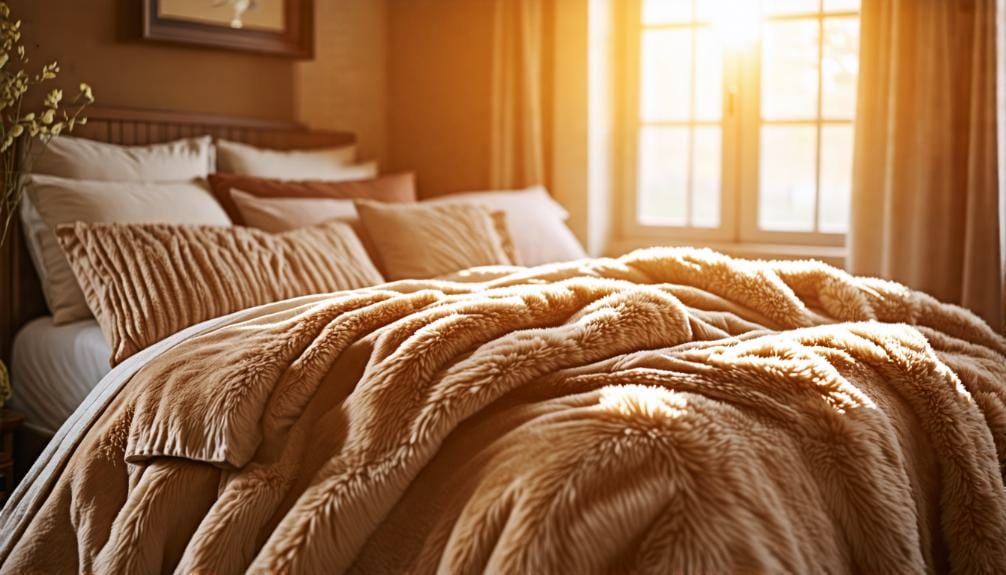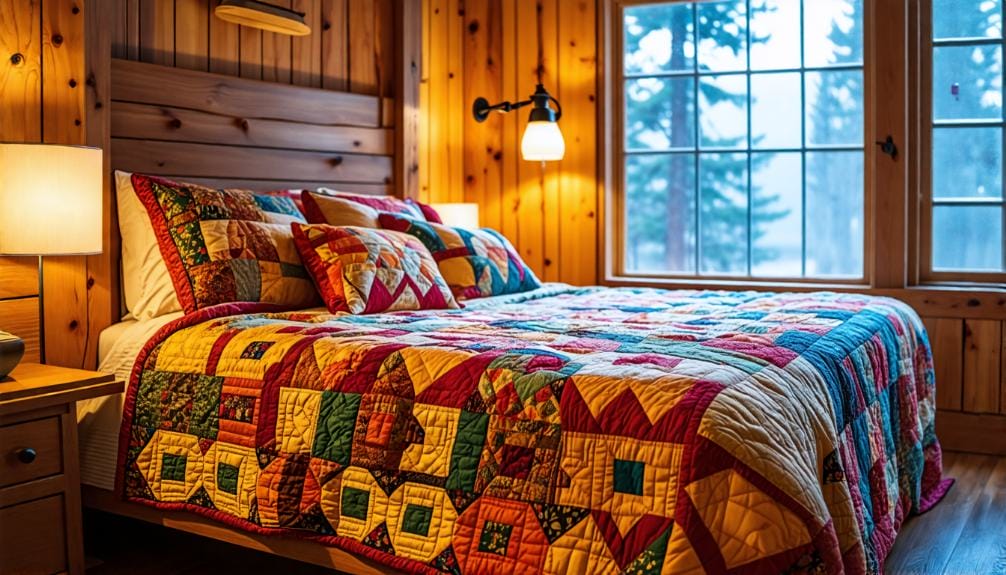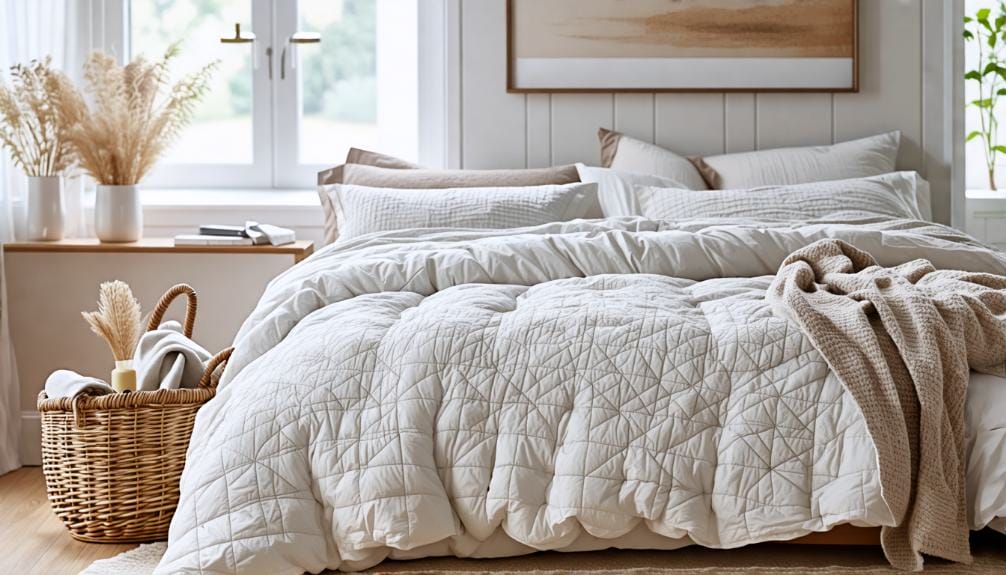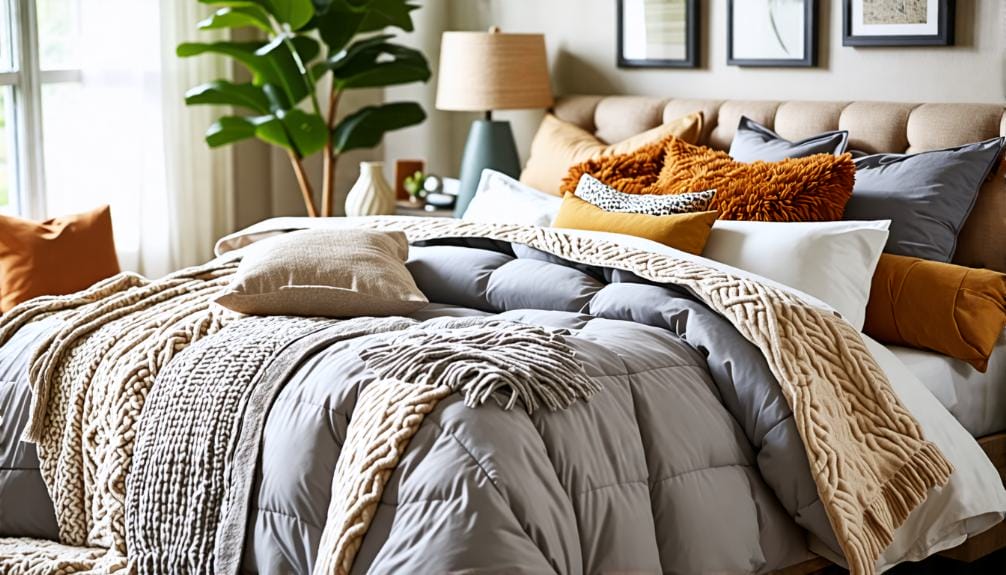Comforter Vs Duvet Vs Quilt: Which One Is Right for You?
When you are faced with the choice between a comforter, duvet, and quilt, it’s essential to contemplate what suits your lifestyle best. Each option has its unique advantages, whether you prioritize warmth, maintenance, or style. Maybe you are someone who enjoys a cozy, vibrant comforter during winter, or perhaps you prefer the versatility of a duvet. But what if you lean towards the lightweight feel of a quilt? Comprehending the nuances can greatly impact your comfort and aesthetic. So, what factors should you really be weighing to make the right decision?
What is a Comforter?

A comforter is a thick, cozy bedding choice that keeps you warm and comfortable, especially on cold nights. It usually has a quilted or stitched design to keep the filling evenly distributed and add a decorative touch. Comforters come in a wide range of styles, colors, and patterns, making it easy to match your bedding with your room’s decor.
For warmth, a comforter is often all you need, providing ample insulation without extra layers. However, cleaning a comforter can be challenging due to its size. It usually requires a large washing machine or a trip to the laundromat. Using a duvet cover can make cleaning easier by protecting the comforter from dirt and stains.
A comforter offers a cohesive look and a cozy feel, but it mightn’t be as versatile as other bedding options. If you want something that’s both decorative and warm, a comforter can help create a snug, inviting sleep environment.
What is a Duvet?
Duvets are a practical and flexible bedding option. They consist of an insert filled with down or synthetic materials, encased in a removable cover. This design makes cleaning easier, as you only need to wash the cover, not the entire insert.
Duvet inserts come in various fabrics and thicknesses, catering to different comfort needs and seasons. A lighter insert is perfect for warmer weather, while a thicker one offers extra warmth in colder months.
The duvet cover not only protects the insert but also adds a decorative touch. You can switch out the cover to match your bedroom decor or mood, offering endless style possibilities.
Though duvets mightn’t appear as neatly finished as comforters, their adaptability makes them popular. By simply changing the cover, you can refresh your bedroom’s look without sacrificing comfort.
What is a Quilt?

Quilts are lightweight bedcovers made from multiple layers stitched together, providing both warmth and decorative appeal. Opting for a quilt means you’re getting a bedding option that often showcases exceptional craftsmanship. Many quilts feature intricate patterns or designs, making them a beautiful addition to any bedroom decor.
Typically, quilts consist of three layers: a fabric top layer, a middle layer for insulation, and a backing layer. This construction makes them breathable and cozy, ideal for warmer nights or as an extra layer during cooler seasons. Quilts can add a nostalgic touch to your space, often reminding you of family traditions or heirlooms passed down through generations.
While quilts offer some warmth, they mightn’t be sufficient for the coldest nights unless paired with other blankets. Their lightweight nature makes them easy to handle and wash, providing a practical yet stylish bedding option. Ultimately, a quilt serves as a functional piece that reflects your personal style.
How Do Comforters, Duvets, and Quilts Compare in Warmth?
Comforters are usually the warmest option with their thick, plush design, making them ideal for cold nights.
Duvets offer adjustable warmth based on the fill and cover you choose, making them versatile for different seasons.
Quilts are lightweight and great for warmer weather but may require extra layers during colder months.
Warmth levels of comforters
Comforters are your best bet for maximum warmth in bedding. They’re perfect for colder climates or anyone who loves a cozy sleep environment. Their thick, plush design traps heat effectively, ensuring you stay snug throughout the night. If you often wake up feeling chilly, a comforter can provide the soft warmth you need without piling on extra layers.
On the other hand, the warmth of duvets depends on their fill and thickness, while quilts are generally lighter and offer less insulation. Quilts are great for warmer seasons but might leave you cold during winter, necessitating extra blankets for comfort.
Consider your local climate and personal sleep preferences. If you prefer a consistently warm bed, comforters are the way to go. If you like to adjust your bedding with the seasons, a duvet might be more versatile.
Ultimately, the choice depends on how much warmth you need and the look you want for your bedroom.
Warmth levels of duvets
Duvets offer various warmth levels depending on their fill material and thickness, helping you tailor your bedding to suit seasonal comfort needs.
Consider the fill type—down, synthetic, or wool—as each provides different warmth levels. A heavy down-filled duvet might keep you cozy in winter, while a lighter synthetic option could be ideal for warmer months.
Unlike comforters, which tend to be thick and less adaptable, duvets give you the flexibility to adjust your bedding based on the season. Pair your duvet with lightweight blankets in summer or add layers in winter for extra warmth. The removable duvet cover also lets you change the look of your bed without sacrificing comfort.
If you get too hot at night, choose a thinner duvet or layer it with lighter blankets. This versatility makes duvets an excellent choice for customizing your sleep environment for ideal year-round warmth.
Warmth levels of quilts
Quilts are a great lightweight option for warmer nights, but you might need extra layers during colder months to stay cozy. Typically, quilts offer less insulation compared to comforters and duvets. Their design, which involves multiple stitched layers, makes them breathable and ideal for summer nights.
However, if you live in a region with cold winters, additional blankets will likely be necessary to achieve the desired warmth. Quilts are perfect for transitional seasons, offering just the right amount of coverage without causing overheating.
They’re versatile enough to serve as a decorative layer on top of a thicker comforter or duvet. If you choose a quilt, consider your comfort preferences and your area’s typical climate.
Layering a quilt with a heavier blanket can work well in colder months, letting you enjoy the quilt’s aesthetic appeal while staying warm. Ultimately, quilts offer adjustable warmth levels, but be prepared to add layers as temperatures drop.
Which Bedding Option is Easier to Maintain?

Choosing the right bedding is crucial for easy maintenance and overall convenience. Duvets are the simplest to keep clean because their covers can be removed and washed just like regular sheets. This makes it straightforward to keep your bed fresh with minimal hassle. On the other hand, comforters can be a bit more demanding to clean since you have to wash the whole piece, which might mean a trip to the laundromat. Quilts, while light and manageable, might need special care depending on their fabric.
Here’s a quick comparison to guide your decision:
| Bedding Option | Ease of Maintenance |
|---|---|
| Duvets | Easy (removable covers) |
| Comforters | Moderate (whole piece) |
| Quilts | Varies (depends on materials) |
If convenience tops your list, duvet covers are your best bet. Comforters offer a cozy feel but can complicate your washing routine. Quilts bring a charming look but might need more care based on the material. Choose according to how much time and effort you’re ready to put into keeping your bedding clean.
How Do Style and Aesthetics Differ Among Comforters, Duvets, and Quilts?
Comforters often feature bold patterns and colors, making them a standout choice for your bedroom.
Duvets offer flexibility with interchangeable covers, allowing you to easily change up your decor.
Quilts bring a traditional feel with intricate designs that add warmth and character to your space.
Style options for comforters
Exploring various style options for comforters reveals unique qualities that cater to different tastes and bedroom themes. Comforters come in a vast array of colors, patterns, and textures, making it easy to match your personal style. From bold prints to subtle hues, comforters not only elevate your bedding setup but also provide the warmth needed for cold nights.
Unlike duvets, which need a cover to add style, comforters have decorative exteriors that can serve as the focal point of your bedroom. They often feature intricate designs, from classic florals to modern geometric patterns, adding a touch of personality to your space. Comforters also come in various materials, like cotton or microfiber, offering options that balance comfort and aesthetic appeal.
Consider how a comforter’s style aligns with your existing decor. The right choice can enhance your bedroom’s appearance and contribute to a cozy atmosphere, making it a key part of your bedding ensemble. A well-chosen comforter blends warmth and style, creating an inviting sleep environment.
Style options for duvets
Duvets offer a practical and stylish way to update your bedding. The key advantage is the ability to change duvet covers, which lets you easily shift from bold patterns to subtle textures, keeping your bedroom decor fresh and aligned with your personal taste. This flexibility makes it simple to adapt your bedding to seasonal trends or your current mood.
Unlike comforters that come as a single piece, duvets allow you to pick a decorative cover that matches your room’s style. You can enhance the look with extra accessories like throw pillows or a bed skirt for added flair. Plus, being able to wash the duvet cover separately makes it easy to maintain cleanliness and a chic appearance.
Ultimately, duvets provide numerous style options, empowering you to create a personalized sanctuary. Whether you lean towards a minimalist design or a vibrant, eclectic look, duvets can fit seamlessly into your vision, ensuring your bedding complements your overall decor.
Style options for quilts
Quilts combine style and craftsmanship, showcasing patterns and textures that can turn your bedroom into a cozy retreat. With a rich history, quilts come in various styles to suit different tastes and preferences. Here are some features that make quilts unique:
- Artistic Patterns: From classic patchwork to modern geometric designs, quilts can reflect your personality and taste.
- Lightweight Materials: Made with breathable fabrics, quilts are perfect for warmer months.
- Versatile Layering: Easily pair quilts with other bedding for added warmth, offering flexibility throughout the seasons.
- Decorative Coverings: Quilts serve as attractive top layers, enhancing your room’s decor while providing comfort.
The right quilt can elevate your bedroom style and ensure comfort. Whether you prefer bold colors or subtle tones, quilts offer a practical and stylish choice, balancing aesthetics and functionality in your sleeping space.
What Factors Should You Consider When Choosing Between Them?

When deciding between a comforter, duvet, and quilt, consider your climate, personal style, and how much effort you’re willing to put into maintenance. Here’s a straightforward comparison to help you make an informed choice:
| Bedding Type | Warmth & Comfort |
|---|---|
| Comforter | Thick and plush, ideal for cold climates. |
| Duvet | Versatile; adjust warmth with different inserts. |
| Quilt | Lightweight; great for warmer weather but may need layers for winter. |
Think about maintenance. Comforters can be tough to wash due to their size, while duvet covers are easy to clean. Quilts usually require gentle care but are often more forgiving than comforters.
Frequently Asked Questions
Which Bedding Option Is Best for Allergy Sufferers?
If you’re an allergy sufferer, consider a duvet with a hypoallergenic cover. It’s easier to wash regularly, helping reduce allergens. Comforters can trap dust mites, while quilts may not provide sufficient protection from allergens.
Can I Use a Duvet Without a Cover?
You can use a duvet without a cover, but it might not be as practical. Without a cover, it can get dirty quickly and may require more frequent washing, which can be a hassle.
How Do I Store My Bedding During Off-Seasons?
When storing your bedding during off-seasons, make sure you clean everything first. Then, fold and place them in breathable storage bags or bins, avoiding plastic to prevent moisture buildup and odors.
What Materials Are Best for Sensitive Skin?
When considering materials for sensitive skin, opt for hypoallergenic fabrics like cotton, bamboo, or silk. These materials are gentle, breathable, and minimize irritation, ensuring a comfortable night’s sleep without causing discomfort or allergic reactions.
Are There Eco-Friendly Options for Comforters, Duvets, and Quilts?
Yes, there are eco-friendly options for comforters, duvets, and quilts. Look for organic materials like cotton or bamboo, and check for certifications like OEKO-TEX or GOTS to guarantee sustainable production and minimal environmental impact.
In Conclusion
In the end, choosing between a comforter, duvet, and quilt comes down to your personal needs and preferences.
If you crave warmth and bold designs, a comforter might be your best bet.
If you want versatility and easy customization, go for a duvet.
For lightweight and breathable options, a quilt is ideal.
Consider your sleeping habits, maintenance preferences, and climate to find the perfect bedding that suits your lifestyle and keeps you cozy at night.
